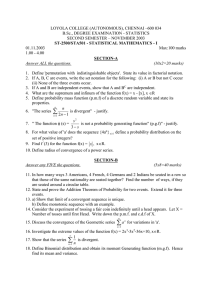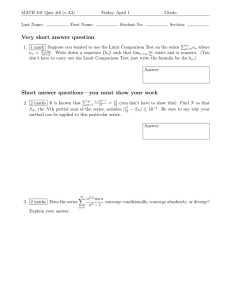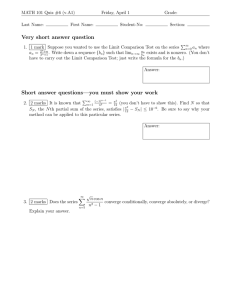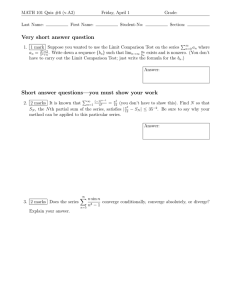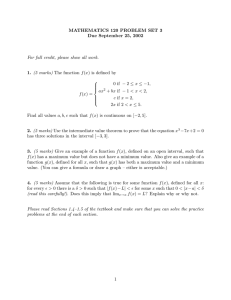LOYOLA COLLEGE (AUTONOMOUS), CHENNAI – 600 034
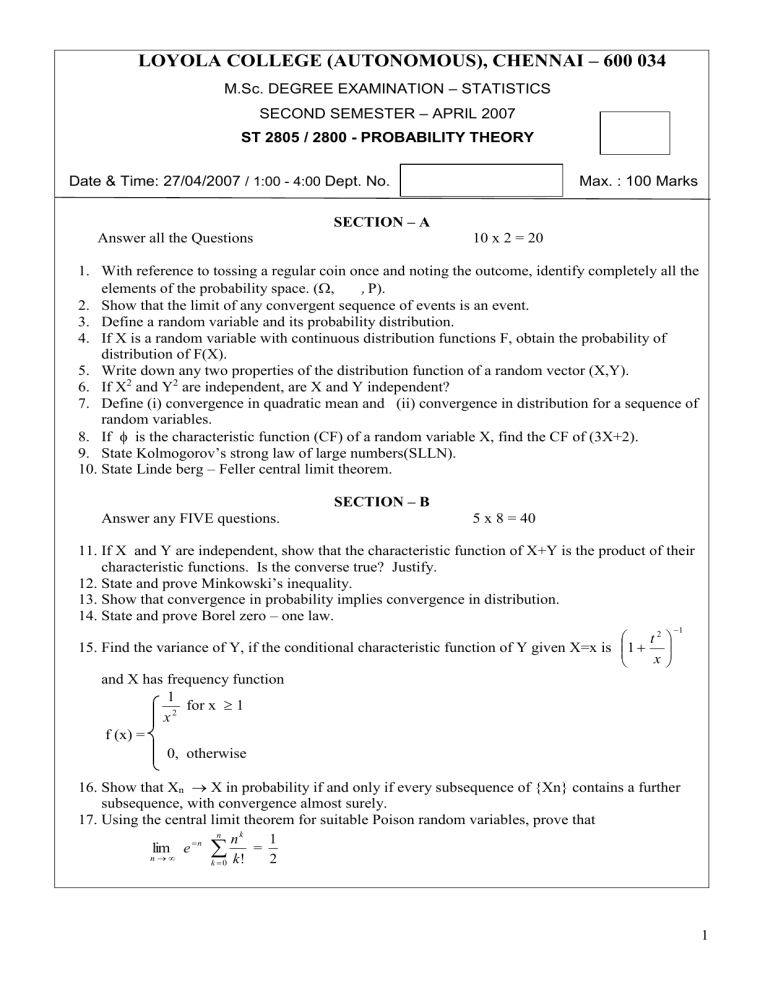
LOYOLA COLLEGE (AUTONOMOUS), CHENNAI – 600 034
M.Sc. DEGREE EXAMINATION – STATISTICS
SECOND SEMESTER
– APRIL 2007
ST 2805 / 2800 - PROBABILITY THEORY
Date & Time: 27/04/2007 / 1:00 - 4:00 Dept. No. Max. : 100 Marks
SECTION – A
Answer all the Questions 10 x 2 = 20
1.
With reference to tossing a regular coin once and noting the outcome, identify completely all the elements of the probability space. (
, , P).
2.
Show that the limit of any convergent sequence of events is an event.
3.
Define a random variable and its probability distribution.
4.
If X is a random variable with continuous distribution functions F, obtain the probability of distribution of F(X).
5.
Write down any two properties of the distribution function of a random vector (X,Y).
6.
If X 2 and Y 2 are independent, are X and Y independent?
7.
Define (i) convergence in quadratic mean and (ii) convergence in distribution for a sequence of random variables.
8.
If
is the characteristic function (CF) of a random variable X, find the CF of (3X+2).
9.
State Kolmogorov’s strong law of large numbers(SLLN).
10.
State Linde berg – Feller central limit theorem.
Answer any FIVE questions. 5 x 8 = 40
11.
If X and Y are independent, show that the characteristic function of X+Y is the product of their characteristic functions. Is the converse true? Justify.
12.
State and prove Minkowski’s inequality.
13.
Show that convergence in probability implies convergence in distribution.
14.
State and prove Borel zero – one law.
15.
Find the variance of Y, if the conditional characteristic function of Y given X=x is
1
t
2 x
1 and X has frequency function
SECTION – B
1 x
2
for x
1
f (x) =
0, otherwise
16.
Show that X n
X in probability if and only if every subsequence of {Xn} contains a further subsequence, with convergence almost surely.
17.
Using the central limit theorem for suitable Poison random variables, prove that n lim
e
n n
k 0 n k k !
=
1
2
1
18.
Deduce Liapounov theorem from Lindeberg – Feller theorem.
Answer any TWO questions
SECTION – C
2 x 20 = 40
19. a) Show that the probability distribution of a random variable is determined by its
distribution function. Is the converse true? (8 marks)
b) Show that the vector X = (X
1,
X
2
, ..., X p
) is a random vector if and only X i
, i=1,2,…p is a real
random variable. (8 marks)
c) The distribution function of a random variable X is given by
0 if x < 0
F(x) = x
1
if 0
x < 1
2
1 if 1
x <
Obtain E(X). (4 marks)
20. a) State and prove Kolmogorov zero – one law for a sequence of independent
random variables. (10 marks)
b) If {X n
, n
1} is a sequence of independent and identically distributed random
variables with common frequency function e -x , x > 0,
X
prove that P[lim sup log n n
1 ]=1
(10 marks)
21. a) State and prove Kolmogorov three series theorem for almost sure convergence
of the series
X n of independent random variables. (12 marks)
b) Show that convergence in quadratic mean implies convergence in probability.
Illustrate by an example that the converse is not true. (8 marks)
22. a) State and prove Levy continuity theorem for a sequence of characteristic
functions. (10 marks)
b) State and prove Inversion theorem. (10 marks)
**********
2
